Editor: Thanks for taking the time to discuss managed services in electronic discovery. Would each of you share a little about your background and experience and how they tie together managed services and eDiscovery?
Avers: Thank you for the opportunity to share today. I’m the Chief Development Officer of TrustPoint International. During my 27 years in the industry, I’ve listened to the needs of corporations and solved the challenges they have faced with data identification, collection, analysis and review. Throughout my experience, corporate counsel have remained consistent with regard to their desire to forecast the logistics, the hurdles and the costs surrounding document requests. Too often they have faced an “open checkbook” scenario in dealing with providers, but with our experience and talent combined with technology, we think we’ve solved that problem and believe managed services are part of the answer.
Wiersma: I’ve spent the better part of 14 years consulting in the legal space around eDiscovery best practices. While still very fast paced, the industry isn’t as frantic as most people think. Organizations are now taking much more thoughtful and defensible approaches to handling eDiscovery, and so in an increasingly commoditized arena, customers are seeking out a single provider that they can trust and partner with to handle the wider spectrum of their discovery needs.
Ingram: I am a litigation technology and eDiscovery professional with over 23 years of experience in the legal profession. Having spent the majority of my career managing litigation support and eDiscovery departments at large law firms and corporations, I’ve been involved in some of the nation’s largest matters involving electronic evidence. Currently I am a Senior eDiscovery Solutions Engineer at TrustPoint International. I also speak frequently at industry trade shows and conferences including New York Legal Tech and those hosted by ACC and ILTA. I also contribute to industry publications such as the National Law Journal and Today’s General Counsel magazine.
Editor: The term “managed services” is used frequently in the information technology arena but may be a new term for many legal professionals. Brian, how would you define managed services?
Ingram: As they relate to the legal industry, managed services can be defined as beginning-to-end litigation eDiscovery services, including project management, expert consulting, ESI processing, data hosting and in some cases even managed attorney document review services. In partnership with the organization, an experienced, dedicated and professional support team delivers a fully customizable solution and a workflow that is repeatable and defensible. I should add that managed services are billed as a flat-rate, subscription-based package, whereas outsourcing each individual case or matter means paying as you go, and bringing the work in-house will mean acquiring the necessary technology and expertise at great cost. The managed services model provides significant efficiency: namely, the seamless extension of an organization’s legal team at a predictable cost.
Editor: Rick, based on your experience in listening and learning about corporate discovery needs from legal department leaders, why do you think the delivery of eDiscovery services from a managed services model is becoming more important to corporations?
Avers: Corporations are already placing multiple demands on their legal operations and their current IT structures, especially given today’s proliferation of data. The managed services approach enables a clean collection and delivery model with a predictable, scalable and appropriate fee structure. An organization can essentially customize its own platform by taking into consideration the myriad needs and demands of the corporation, much the way a family does with its cell phone package. At TrustPoint we have experience in this area as we currently have over 22 cases hosted with a large multinational pharmaceutical provider and another 17 with a fast-growing international bank. Both of these solutions are unique in their platforms but very alike in their delivery model. (We also offer this platform to outside counsel, which ultimately supports their corporate clientele.)
Editor: You mentioned predictability: what exactly does that predictability look like from the vantage point of a corporate legal department?
Wiersma: There are two primary components to consider. The first is predictability of cost. Historically, eDiscovery costs have been very difficult to forecast. I recently spoke with an in-house legal representative who described this challenge. Under their current model, his organization typically defers to many outside counsel, and then each of those outside counsel relies on as many as four or five service providers. Just imagine the variant pricing models they end up evaluating. Under a managed services model, a client can gain instant predictability by working with one provider that can determine their annual capacity and then clearly define a bundled solution around those metrics. The end result is a flat-rate, all-inclusive pricing structure at a fraction of the cost the client would pay for individual eDiscovery events on an episodic basis, as well as an accurate line of sight into otherwise unpredictable expenditures.
The second is predictability around the service and process. If a client is reliant on the disparate model described above, it’s at the mercy of a bunch of different strategies, approaches, people and technology. Working with one trusted partner facilitates consistency, repeatability and an affordable approach to handling the discovery lifecycle. And, while I’m not suggesting that one size fits all, there’s definitely room for standardization in the overall process. Through practice, a dedicated team of experts becomes very familiar with the client’s data, their expectations and the type of matters they encounter, enabling a level of consistency such that when that rogue case or matter comes along, the trusted relationship and good communication between the teams is in place, and the project can be approached on an individual basis. Dedicated teams, consistent methodologies, dependable technology and consolidated billing all translate to a more efficient process.
Editor: You also mention capability. What types of services are available as a managed service?
Wiersma: TrustPoint has three solutions that can be tailored to a customer’s constantly evolving needs, whether that is a corporate legal department or a law firm. InfrastructureNOW provides clients with an enterprise-grade managed infrastructure to support the deployment and management of agnostic litigation applications. This infrastructure-as-a-service offering delivers a fully redundant, private, custom hosting environment with dedicated project management and a dedicated support team. The applications are essentially managed by the firm or corporation, but TrustPoint handles the IT.
ReviewNOW with Relativity provides clients with a private, fully hosted and supported environment for the industry-leading Relativity review platform at one predictable cost. ReviewNOW gives clients the ability to operate their own private and secure Relativity environment without having to purchase Relativity software and infrastructure.
Last but not least, we consult with many clients on which custom solution might make the most sense for them, and we’ve found that most corporate legal departments are interested in DiscoverNOW. This third offering provides clients with access to a portfolio of electronic discovery services from collection to production at one predictable cost. It gives our clients immediate access to industry-leading applications and expertise without the requirement for procuring and deploying hardware or software or hiring additional personnel. DiscoverNOW enables consistency and standardization, and creates an effective overall workflow and process, with services that might include collections, processing, early case assessment, technology-assisted review and hosted review. More importantly, TrustPoint’s dedicated consulting and project management team is only focused on that one individual customer’s needs, enabling the seamless extension that Brian alluded to earlier.
Editor: Since these offerings are typically delivered from the data centers of managed service providers such as TrustPoint, how do you put a client’s mind at ease in regards to the security of their data?
Ingram: Obviously security is of the utmost importance, and we here at TrustPoint maintain two SSAE SOC 2 certified data centers. We deploy industry-leading technologies for both physical security and network security, including encryption and anti-intrusion protocols. We have a dedicated and secure high-speed link between our two data centers. We’ve also developed – and we frequently test – our own security procedures and policies to ensure that no vulnerabilities exist, and that there isn’t a single point of failure anywhere. This includes disaster recovery plans, business continuity assurance plans, business interruption analysis plans and, finally, HIPAA compliance.
Editor: Many providers can deliver a managed service, so how do providers like TrustPoint differentiate themselves from others?
Wiersma: I think we can start with some facts about TrustPoint. We have worldwide capability with local presence in 15 U.S. metro cities and facilities and review centers throughout the country. Since 2008 we’ve led over 800 clients and processed over five petabytes of data; we've hosted over three petabytes of data for over 100,000-plus active users of Relativity. We’ve worked with clients in the AmLaw 200 and the Fortune 100, as well as on governmental matters.
But more important is our ability to establish trust with our clients. To differentiate in the managed service arena, we focus on dedicated customer support, which includes ensuring that clients have support personnel throughout the entire discovery life cycle and have a dedicated client services manager who serves as an inroad into their dedicated project management team. TrustPoint brings this whole pool of resources to clients, while the team ensures that the process continues to evolve based upon client needs.
Avers: TrustPoint’s been operating and growing both nationally and internationally for over five years now. Our experience on the technology and review sides of discovery and staffing has helped us both identify and rectify some of the inefficiencies of older models. The issues that legal departments face today are very close to their hearts, and we know the stakes can be very high. I think the differentiator with TrustPoint is the fact that our expertise begins on the left of the EDRM with legal hold and continues all the way through review (at any moment we have 400 to 600 contract reviewers working around the country) and production.
Furthermore, after every project we ask ourselves, how did that case go? What could we have done better? How could we have reduced the cost for the end user? I suggest that anybody embarking on finding a managed services provider take a hard look at that team in the field to make sure that its members understand all the components of discovery, and that they don’t approach it strictly from a technology solution perspective. They not only need to ask the hard questions of providers, but they also need to have a provider who continually asks the hard questions necessary for increased efficiency and decreased costs.
I believe the name of our company says it all in terms of why our clients choose to work with us. At the end of the day, our clients tell us that they feel comfortable working with TrustPoint, that they trust us to partner with them in the eDiscovery litigation support arena.
Editor: In closing, when you get asked for advice on managed services from legal professionals in general and corporate legal departments specifically, what are the key considerations you point out for them?
Wiersma: There is obviously a long list you have to consider when deciding on a managed services provider. If you take a 30,000-foot view, you need to work with a provider that can deploy a custom approach and can evolve as you evolve. You need to be very comfortable with their support team. You want to make sure they have the appropriate dedicated and certified resources that match the skill sets you need and want – and that they can handle your unique, constantly shifting workload. The ability to work together seamlessly despite ongoing change should be one of the most significant factors in your decision. General considerations include the availability of custom and consultative solutions; working together as a dedicated team; and ensuring that you achieve the projected cost reduction, improved project agility and decreased project times. You should be able to achieve all of these with the right managed services provider.
Published May 30, 2014.





